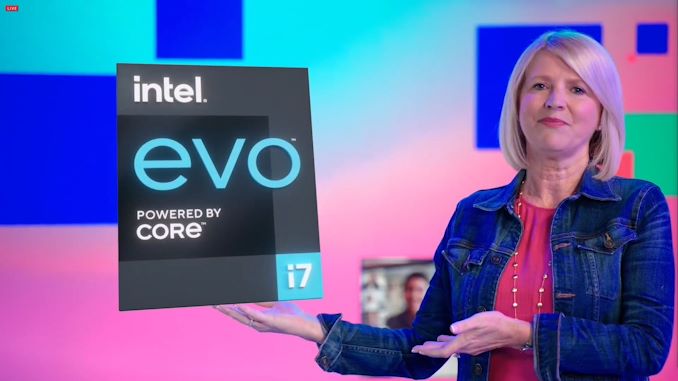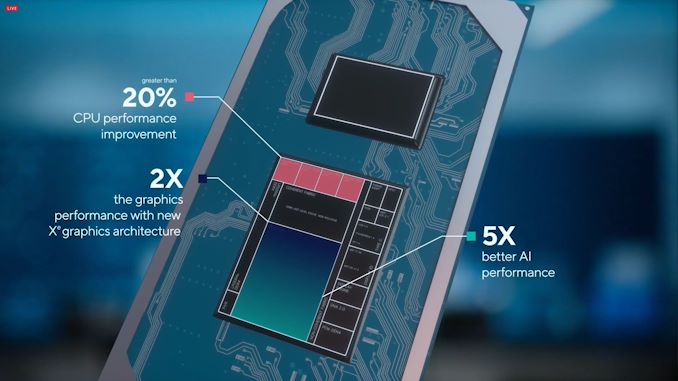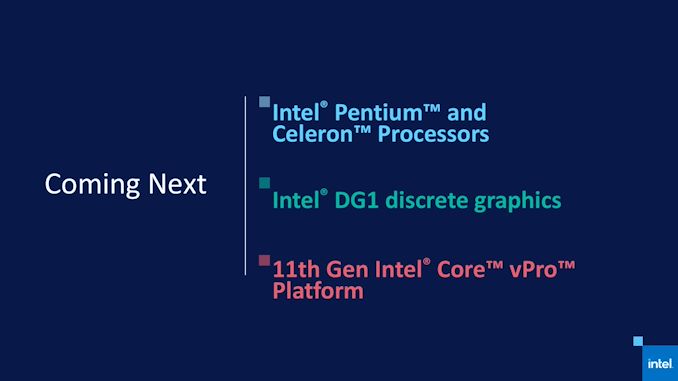Intel Launches 11th Gen Core Tiger Lake: Up to 4.8 GHz at 50 W, 2x GPU with Xe, New Branding
by Dr. Ian Cutress on September 2, 2020 12:45 PM ESTNew Branding: Intel, Intel Iris Xe, and Intel EVO
Since the introduction of Ice Lake, Intel’s logo design has seemed a bit off-kilter. The company changed how it named its processors, ditching the U and Y designations, instead of focusing on the ‘G7 and G4’ elements as well as the graphics. While those were Intel’s 10th Generation Core processors, they were categorized in a seemingly different way. Now a year later, changes are once again afoot. With the introduction of Xe graphics into the mix with Tiger Lake, the company is putting new logos and branding into the mix.
The new stickers on the laptops will look something like this. Intel has decided that its logos need to have a mix of lower case letters and capital letters for Core and Iris, despite the Intel part being in complete lower case and the ‘Graphics’ or ‘Powered By’ are all capitalized (at least it isn’t with backwards letters?). The Xe has that e in superscript as well, for the ‘eXascale for Everyone’ element of the graphics portfolio.
There is also Intel Evo, the new name for Intel’s Project Athena program, which we talk about later.
Beyond this is a full change for the Intel logo. It was stated that Intel only ever changes its logo when there is a big shift inside the industry. Today is apparently that shift, despite Intel's presentation being fairly minimal - I would have expected a logo change to occur during a large event or such. Intel says this is the third time it has fundamentally changed its logo.
Project Athena Becomes Intel Evo
With the launch of the previous generation of products, Intel introduced its Project Athena verification program. Similar to how it tried to push for ultraportable notebooks back in the day, Project Athena was a set of specifications that Intel believed were important to the premium notebook owners in the current day. This included things like minimum battery life requirements, support for Thunderbolt and Wi-Fi 6, a good display, support for AI, and a specific level of responsiveness.
In order for a laptop to be designated as a Project Athena design, it had to be validated by Intel. More often than not, Athena notebooks were co-developed with Intel anyway, making validation not much more than a formality. At the time Intel stated that Project Athena was more of an OEM standard to help push the industry along the leading edge – version 1.0 of the specification was ultimately a stepping stone to more stringent updates to the standard we learned.
Because Athena was a program designed for the OEMs rather than the customer, Intel had not necessarily worked out the marketing side of the equation. At a simple level, it was expected that these devices would, if they followed the specification, speak for themselves in offering better-than-normal user experiences equipped with the latest technology. However, at some point, we expected Athena to become end-user visible as well.
So for this Tiger Lake launch, Athena is now getting that splash of marketing, and Intel is calling any device that qualifies under the latest updates as ‘Intel Evo’. The Evo part of the name is clearly meant to be a calling to the evolution of the future generation of products.
What surprises me a bit is that the first generation of Athena was meant to be, at least on some level, CPU vendor agnostic – some of the special sauce from Intel made it easier for Intel devices to meet the specification, such as built in Thunderbolt and CNVi-based Wi-Fi 6 reduces the power consumption. With Intel Evo branding, any semblance of it being an industry-wide specification to work towards now goes out the window. While any Evo qualification is still a good thing to have, with the promise of a good user experience and the latest technology, there’s no escaping the fact that this program is now honed in for Intel-specific systems.
Intel 11th Gen Core Tiger Lake Performance
As usual, posting performance numbers isn’t really our thing – we prefer to get the hardware on hand and test for ourselves. Intel has a habit of not stating full system configurations during its presentations, and rather directing the press to look at a section on a website after the fact. To that end, we’re not going to republish reams of Intel’s own numbers here. The high level numbers that are perhaps with promoting are as follows.
When comparing an Intel Core i7-1165G7 Tiger Lake system to an AMD Ryzen 7 4800U system (both configurations unknown at this point), Intel states it has the following performance advantages:
- +28% Compute (SYSmark 25)
- +67% Graphics (3DMark Fire Strike)
- +300% AI (MLPerf)
As always, Intel’s need to promote ‘performance using real world benchmarks’ rubs up against the fact that it also posts these sorts of synthetic tests as well – especially when system configurations are no longer provided directly where the numbers are in the presentation. Intel does have ‘real world benchmarks’, directly in the next slide, but for slide #4 in a day of announcements, offering synthetics – especially ones that are known to favor Intel – is a bit frustrating. Surely an aggregate number of those real-world tests would be a better starting point for any presentation.
We will be doing our own testing when we get a Tiger Lake system in for testing.
Coming Next: Devices and Future Intel Announcements
Now that Intel’s Tiger Lake mobile processors are announced, OEM partners will also be announcing notebooks and laptops in the upcoming weeks – in fact a few will do so today. The other half of Tiger Lake still needs to be disclosed – at Architecture Day we were told that Tiger Lake scales to 65 watts, so most of us has assumed that this means a 45W to 65W range of processors, up to 8 cores, is coming. No word on that from Intel as of yet.
As a final slide from Intel’s deck, the company has clarified what to expect from its next few announcements (which we assume is from now through to the end of the year, at least from the client side of the business).
We should expect to see Intel Pentium and Celeron notebook processors later this year, along with the vPro versions of the Tiger Lake processors announced today. Perhaps more exciting is the DG1 discrete graphics platform, which is also promising to show its head. Given the recent high-end graphics announcements, it’s going to be fun playing with something more mid-range.
















348 Comments
View All Comments
hojnikb - Thursday, September 3, 2020 - link
Did you actually look at the review you listed? AMD beats Intel in efficiency by a decent margin and if we look at max boost frequency amd is far away. Same for power consumption, that part can eat 250W at max boost.AMDSuperFan - Thursday, September 3, 2020 - link
Yes the article clearly says that Intel is much more efficient. The only way it isn't more efficient is if it is overclocked. The stock chip on 14nm always seems to beat the 8 core 7nm AMD in performance and efficiency. I can't believe a 14nm chip runs so much cooler than the 7nm chips and at higher performance and clocks. This is making me quite nervous and scared.Spunjji - Friday, September 4, 2020 - link
Turbo isn't overclocking, Mr Obvious Shill. The USEFUL page of that article ( https://www.techpowerup.com/review/intel-core-i7-1... ) clearly says that Intel are more efficient on single-thread workloads and less efficient on multi-core workloads when running at the same performance level. They only come close to (and still lose to) AMD for multi-threaded efficiency when the chip runs at base clocks, at which point the chip is also slower than the AMD competition.And guess what: even when your primary task is single-threaded, you can bet your background-tasks aren't!
Spunjji - Friday, September 4, 2020 - link
Funny that you seem to have ignored the turbo figures that sit at the precise opposite end of the chart, meaning that to actually match AMD on performance Intel's 14nm+++ CPU has to pull *114W more power*.Thanks for sharing your "concerns", though, three kids in an Intel-branded trenchcoat! Uh, I mean, "AMDSuperFan" 😉😉😉
vladx - Friday, September 4, 2020 - link
Oh boohoo, are you sad he stole your nickname?Spunjji - Monday, September 7, 2020 - link
For someone who has repeatedly called me obsessed, a fanboy and a shill, you really did just go through this whole thread and reply to me with snarky bullshit. Here you're white knighting for the most obvious troll since Trump ran for president.I'm happy to admit I post on here a bunch. I'm a tech-head and it bugs me when people post lies and nonsense. What's your excuse for defending a liar?
JayNor - Wednesday, September 2, 2020 - link
"However the underlying clock-for-clock performance improvements are minimal ..."Surely their dual ring bus, cache updates, PCIE4, memory speed updates, Thunderbolt 4 contribute something more than "minimal" improvements to the performance.
hojnikb - Thursday, September 3, 2020 - link
IO will have no impact on clock fro clock performance.Tomatotech - Saturday, September 5, 2020 - link
The old mainframes had pretty low performance but absolutely huge I/O enabling them to do data runs that were impossible for a long time with home comouters.Even though a few years later home computers were approaching mainframe speeds, home computers still didn’t have the I/O power to compete (arrays of memory, racks of disk space, ultra-high speed drum scanners and readers, high speed printers and cutters). This was all before cloud computing and thunderbolt came along.
vlado08 - Wednesday, September 2, 2020 - link
In the article i7-1160G7 has a base frequency of 1200 MHzHere https://www.intel.co.uk/content/www/uk/en/products...
The Configurable TDP-up Frequency of i7-1160G7 is 2.10GHz at Configurable TDP-up 15W
The Configurable TDP-down Frequency of i7-1160G7 is 900MHz at Configurable TDP-down 7W
So the 1200MHz form the article is probably for 12W because:
Here https://ark.intel.com/content/www/us/en/ark/produc...
The Configurable TDP-up Frequency of i7-1165G7 is 2.80GHz at Configurable TDP-up 28W
The Configurable TDP-down Frequency of i7-1165G7 is 1.20GHz at Configurable TDP-down 12W
So for i7 4cores/8threads we have these "base"(guaranteed) frequencies :
2.80GHz at 28W
2.10GHZ at 15W
900MHz at 7W